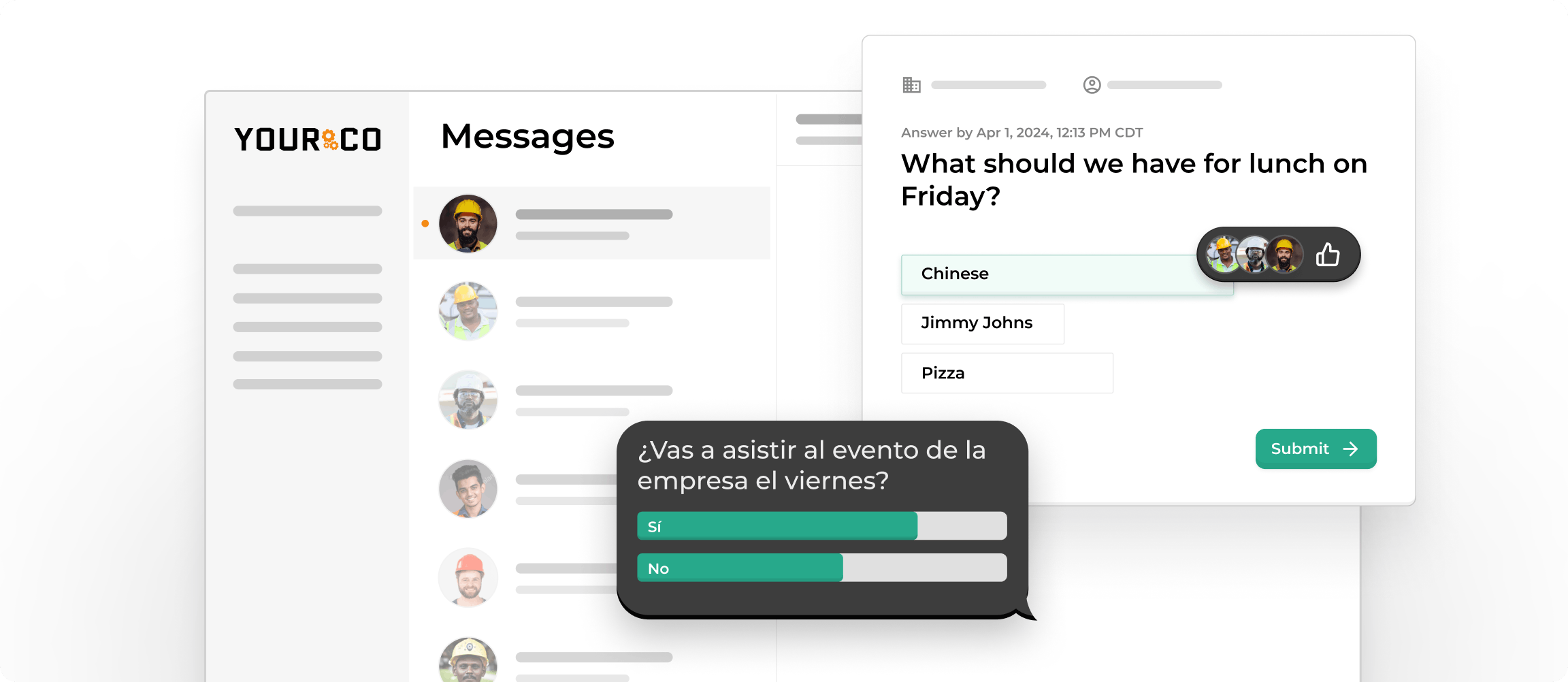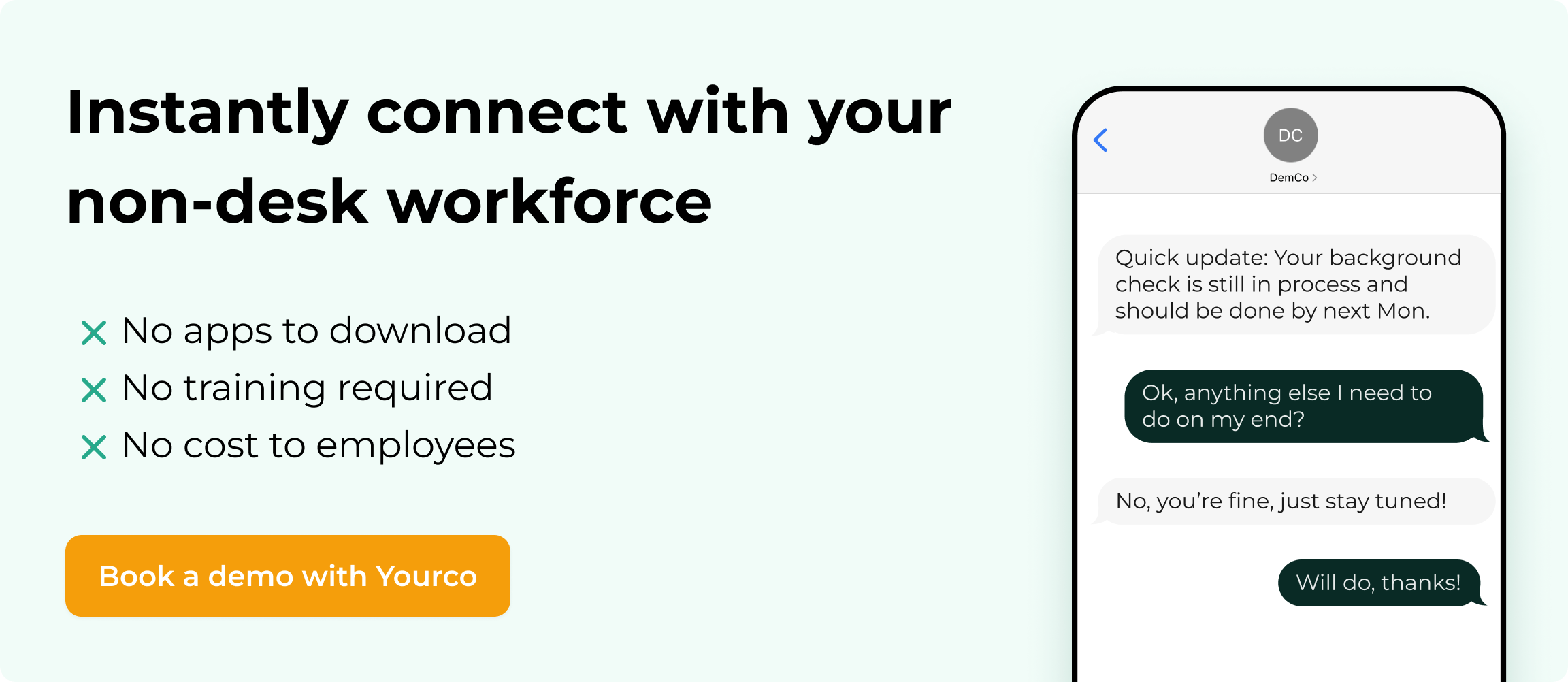Employee Survey Templates: Boost Response Rates with 4 Must-Have Examples


4 Must-Have Templates for Your HR Toolkit
You don't need to run complicated campaigns to gather meaningful employee insights. Well-built templates shorten prep time, keep questions consistent, and nudge employees toward completion. Below are four proven formats you can copy, tweak, and launch today.
Template 1: Internal Communication Audit Survey
Clear, timely communication is the backbone of a safe and productive workplace. But many organizations still rely on outdated or inconsistent methods that leave employees in the dark. An internal communication audit survey helps HR teams identify gaps, evaluate existing tools, and pinpoint what employees actually prefer.
Keep the survey short and practical — 6 to 8 questions are enough to reveal whether your current channels are effective and where improvements are needed.
Example questions:
- ‘’Do you receive important updates in time to act on them?’’
- ‘’Do you feel communication from leadership is too frequent, not frequent enough, or about right?’’
- ‘’Do you prefer updates through SMS, email, or a company platform?’’
- ‘’Are there tools or platforms you find difficult or inconvenient to use?’’
Share a summary of findings with employees within 30 days and outline one or two clear actions the company will take to improve communication. This transparency builds trust and reassures teams that their feedback shapes future practices.
→ Access the Free Communication Audit Survey Template to assess your company’s communication systems quickly. Includes ready-to-use questions to help you run your next communication audit with ease.
Template 2: Employee Engagement Survey
A quick, recurring engagement pulse tells you how connected people feel to their work and where frustration is creeping in. Aim to run it quarterly or twice a year so trends are easy to track.
Start with an outcome metric such as eNPS or an overall engagement score, then add driver items on leadership, growth, and recognition. Keep the questionnaire to 8-10 questions so non-desk workers can complete it in under five minutes on a phone.
Example questions (five-point Likert scale: 1 = Strongly Disagree, 5 = Strongly Agree):
- ‘’I understand how my work contributes to the company's goals’’
- ‘’My manager gives me useful feedback that helps me improve’’
- ‘’I see a clear path for career growth here’’
- ‘’I receive recognition when I do good work’’
- ‘’I would recommend this company as a great place to work’’
Follow-up strategy: Share the top three insights with the whole team within two weeks, commit to one visible action per insight, and revisit scores next quarter. Closing the loop quickly boosts future response rates and shows employees their voices matter.
→ Download the Free Engagement Survey Template to launch your next pulse check in minutes. Includes ready-to-use questions, follow-up steps, and a mobile-friendly layout.
Template 3: Onboarding Survey
New hires form lasting impressions fast, so touch base at day 7, day 30, and day 90. Each checkpoint should spotlight training clarity, resources, and cultural fit.
Keep onboarding surveys to five to seven items. Mix multiple-choice for quick sentiment checks with one open-ended prompt to capture detail.
Key questions:
- ‘’By the end of my first week, I knew whom to ask when I had questions’’
- ‘’Training materials were easy to access and understand’’
- ‘’What could have made your first month smoother?’’
For field or warehouse roles, deliver the questionnaire via SMS with a single-tap link and trim jargon—simple language prevents confusion for employees reading on the go. Use results to fine-tune orientation schedules, assign mentors, and flag any resource gaps. A quick recap message to the cohort signals that you heard them and are acting on their input.
→ Get the Free Onboarding Survey Template to improve first impressions from day one. Includes 7-day, 30-day, and 90-day check-ins with SMS-ready phrasing.
Template 4: Exit Survey
When someone decides to leave, an anonymous exit survey pinpoints what could have changed their mind and helps you keep remaining teammates engaged. Send the link before the employee's last day and allow a week for completion.
Combine quantitative ratings with space for comments, balancing the need for metrics with a chance to "speak freely." Focus on levers you can still improve:
- Primary reason for leaving (select one): Career advancement, Wages, Work-life balance, Management, Other
- Rate your satisfaction with each of the following (1-5): supervision, growth opportunities, recognition, workplace safety
- Open-ended prompt: What could we have done differently to encourage you to stay?
To encourage honesty, reiterate confidentiality and store responses separately from HR files. After analyzing patterns, such as repeated mentions of limited progression, share a summary with managers and outline a corrective plan, such as clearer promotion pathways or updated wage structures.
→ Use the Free Exit Survey Template to capture honest feedback before good people walk out the door. Includes a mix of multiple-choice and open-ended questions, plus analysis tips.
By weaving these four templates into your feedback rhythm, you gain a 360-degree view of the employee journey, encompassing first impressions, day-to-day engagement, and departure drivers, without spending hours drafting questions from scratch.
Why Templates Beat Building from Scratch
When you sit down to craft an employee survey, a blank page can steal hours you don't have. A proven template removes that hurdle. The core questions, response scales, and introductory text are already there, so you can launch in minutes. Templates also keep you consistent. Using the same structure across departments and over time lets you compare results and track trends with confidence.
Quality templates come pre-loaded with details you might miss if you build from scratch. Skip logic, mandatory-field validation, and confidentiality language are built in, reducing the risk of data gaps or compliance issues. Since everything is pre-tested, you can duplicate the survey, adjust wording for a specific site, and push it out to dozens of locations without rewriting instructions each time.
Well-designed templates also earn more completions. Clear wording, logical flow, and manageable length prevent survey fatigue, which drives drop-offs in longer, DIY forms. Templates free up your calendar, standardize your data, and keep employees engaged all the way to the final question.
Key Components of an Effective Employee Survey Template
Crafting a survey that employees will actually complete requires the intention behind every question.
Start with a single metric that matters, such as an engagement score or eNPS, which you can track over time and compare across teams. Build from there with "driver" questions that target leadership effectiveness, recognition practices, career growth opportunities, and other factors that directly influence your headline number.
Strong templates blend three question types strategically:
- Likert-scale items give you clean data for trend analysis
- Multiple-choice questions help categorize responses quickly
- Open-ended prompts let employees surface issues you didn't anticipate
Arrange these in a logical flow that moves from broad sentiment to specific experiences. This simple structure keeps people oriented and prevents the survey drop-off.
Be mindful of the survey's length, as it can significantly impact your response rates. Keep questionnaires under ten minutes—anything longer risks fatigue and half-hearted answers that skew your data. Open with a brief purpose statement that explains why you're collecting feedback, and close with an explicit confidentiality promise. Employees share more honest responses when they know their answers aren't traced back to them.
Non-desk employees need special consideration. They often respond on small screens during short breaks, so questions must be concise, jargon-free, and easy to navigate with a thumb.
- Replace lengthy comment boxes with optional voice notes or a single open text field.
- Offer the survey in every language spoken on your shop floor.
- Ensure the link works over basic mobile data without requiring app downloads or logins.
This approach means both warehouse pickers and office staff can share feedback with equal ease.
How to Customize Your Survey for Better Results
Templates provide a strong foundation, but personalization drives superior outcomes. When you translate generic questions into your team's everyday language, response rates climb, and the insights you gather become far more useful.
Use Familiar Language and Tools
Begin by swapping vague terms for the names, tools, and processes your people actually use. A question like "I have the resources I need to do my job" works better when you name the exact equipment or software your warehouse relies on. Focus on the things that really shape engagement, such as leadership, recognition, and safety, so they mirror the realities of your own workplace. This way, you can act on the findings quickly.
Customize by Department
Next, tailor the questionnaire to each department's challenges. Production crews may care about equipment uptime, while retail associates focus on schedule predictability. Mix short rating questions with a few open-ended prompts for deeper insights. Keep free-text boxes limited so answering on a phone feels painless.
Make Wording Easy to Understand
Plain language matters, especially for non-desk employees. Avoid jargon or HR-speak. Before rolling it out widely, test your survey with a small group to make sure the questions are clear. Piloting a survey with a small group is a general best practice to catch confusion early and improve completion rates.
Prioritize Accessibility
Accessibility matters just as much as content. Offer every form via SMS, QR code, or employee communication apps, and provide versions in the languages your workforce speaks. Mobile-friendly distribution paired with simple progress indicators removes friction and lifts completion rates.
Motivate Participation
Finally, motivate participation. Small spot prizes, public thank-yous, or an extra break can nudge even skeptical employees to share honest input. Before launch, include a brief privacy statement explaining anonymity and data use — clear assurances build trust and align with compliance guidance.
The more your survey reflects the real language, roles, and rhythms of your workplace, the more likely employees are to engage and trust that their voice matters.
Customizing Surveys for Manufacturing, Hospitality, and Logistics Teams
Employee engagement looks different depending on where the work happens — and so should your surveys. For industries such as manufacturing, hospitality, and logistics, surveys must be tailored to fit within fast-paced, shift-based environments where time and attention are limited.
In manufacturing, employees often care about safety, supervisor support, and equipment reliability. Focus on short, direct questions like:
- “I feel safe using the tools and equipment provided.”
- “When I raise a concern, my supervisor follows up.”
Avoid long surveys during production hours. Instead, send a quick five-question pulse via SMS before shift change or during break times. Use simple language and offer a translation if needed, especially for multilingual shop floors.
In hospitality, team dynamics and communication matter just as much as customer feedback. Include questions that reflect the pace and pressure of guest-facing roles:
- “I feel supported by my team during busy shifts.”
- “Training prepared me to handle guest requests confidently.”
Hospitality workers are often moving between floors or dealing with guests, so distribute surveys by QR code in break rooms or through a scheduling platform they already use, or consider using Yourco. Add one open-ended question to catch anything managers may have missed.
In logistics and warehousing, shift consistency, workload fairness, and recognition are top concerns. Ask questions like:
- “I understand my tasks at the start of each shift.”
- “Workloads are distributed fairly among my team.”
Because warehouse workers may not have access to a desktop or company email, lean on mobile access. Short, timed surveys ( ideally under five minutes) with clear incentives (like a break raffle or thank-you snack) help boost participation.
Across all three industries, keep it concise, offer mobile delivery, and make sure the language matches real-world workflows. When surveys reflect the pace and priorities of frontline teams, participation goes up, and the feedback you collect becomes far more useful.
What to Do After You Collect Responses
When you gather fresh data, put it to work:
- Check how many people responded: Strong response rates mean reliable findings, while low participation signals you need better survey distribution methods or reminders next time.
- Move through quick passes: Review completion patterns, segment the data, and identify themes that most influence engagement and turnover.
- Look for drop-off points: If many employees abandoned the form at a particular question, it probably needs rewording or repositioning.
- Segment the results: Slice the data across demographics such as department, location, tenure, or shift type. This reveals hidden patterns. For instance, warehouse teams may flag equipment issues while office staff mention unclear growth paths.
- Analyze comments: A quick sentiment scan can flag common pain points in your survey feedback, but don't stop there. Read a sample of raw responses to catch nuances that automated analysis misses. Group recurring ideas like unsafe equipment, unclear schedules, and lack of recognition into two buckets: fast fixes and longer-term projects.
- Share findings transparently: Summarize top results in plain language and circulate them to leadership and frontline teams alike. Include three essentials: what you heard, what you plan to tackle first, and when employees can expect updates. This clarity maintains trust without compromising anonymity.
- Co-create an action plan: Invite managers and a representative group of employees to brainstorm solutions for each priority theme. Assign owners, deadlines, and success metrics. For example, if night-shift logistics workers reported communication gaps, you might pilot pre-shift text briefings for two weeks and track missed handoffs afterward.
- Measure and repeat: Schedule a follow-up pulse or quick poll 30–60 days after implementing changes. Compare new data against the original baseline to confirm whether the intervention moved the needle. Close the loop by celebrating wins and outlining the next set of improvements. When employees see that honest input sparks real change, response rates climb, and engagement follows.
Done right, this process turns survey results into a steady cycle of listening, action, and improvement that strengthens culture over time.
Create a Successful Survey Program and Turn Feedback Into Action
You'll get the most value from employee feedback when surveys are simple to complete and lead to real change. Keep questionnaires short (five to eight questions is ideal) to avoid fatigue, especially on mobile. Before launching, explain why you're asking for input, how long it will take, and what you'll do with the results. This clarity builds trust and boosts participation.
Make anonymity a priority. When employees know their answers are private and results are shared only in summary, they're more likely to be honest. After each survey cycle, close the loop: share what you learned, what you plan to change, and when those changes will happen.
Consistency helps too. Run surveys quarterly, repeat key questions to track progress, and mix in new ones based on emerging issues. And always meet workers where they are—offer SMS links, QR codes, or kiosks, and provide translations in the languages they speak.
Well-designed templates make all of this easier. They come preloaded with outcome metrics, tested driver questions, and built-in confidentiality language. You skip the formatting, launch faster, and gather clean, comparable data.
When you're ready to launch, consider using Yourco. Our platform lets you send mobile-friendly forms in 135+ languages by SMS, capture anonymous replies, and view results in a single dashboard. No downloads, logins, or technical headaches required. Give your team a voice and act on it today.
Try Yourco for free today or schedule a demo and see the difference the right workplace communication solution can make in your company.
Frequently Asked Questions
How long should a mobile survey take to complete?
Aim for five minutes or less. Brief forms reduce drop-offs and respect the time pressures of shift work.
Do employees need to download an app first?
No. A web-based link delivered by SMS, QR code, or kiosk browser removes the extra step of installing software.
How long should a customized survey be?
Aim for 5–8 core questions plus two optional open-ended prompts. This balance keeps mobile completion under five minutes.
Do I need a legal review before launching?
Yes. A comprehensive legal review is necessary to ensure your privacy statement, data retention plan, and any demographic questions meet local regulations.
What's the best way to encourage non-desk workers to respond?
Distribute the form through SMS links during paid time, offer a small incentive, and clearly explain how their input will drive real changes.
How soon should I share results with employees?
Aim for within two weeks. Timely transparency shows respect for employees' input and keeps momentum high for action planning.
What if the response rate is low?
Review distribution channels and timing, simplify questions that saw high abandonment, and explain the form's purpose more clearly in your next invitation.
How many action items should I tackle at once?
Focus on two or three high-impact themes. Trying to solve everything immediately dilutes resources and makes progress harder to track.




